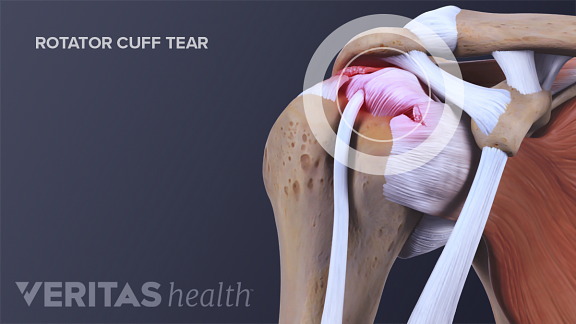By Amy Haddad
“If you’ve had a rotator cuff tear, physical therapy will be important to help you regain shoulder strength and range of motion.
Here are examples of several typical exercises and stretches you may encounter on your road to recovery.
1. Pendulum swing
- Stand to the side of a table, steady chair, or railing and place the hand of your uninjured arm on the object for stability.
- Gently lean forward without rounding the back and allow the affected arm to dangle freely. Then, lightly move this arm forward and back.
- Starting in the same position, move your arm in and out (side-to-side).
- Starting in the same position, move your arm in small circles. Start in a clockwise motion, then reverse and do it counterclockwise.
- Repeat the exercise with the other arm.
2. Crossover arm stretch
- Stand up straight and relax your shoulders. Take a few deep breaths if you need to relax.
- Stretch the affected arm across your chest, but below your chin; reach as far as possible.
- The healthy arm helps by holding the elbow area of the affected arm.
- When performing this exercise, you should feel a stretch—not pain.
- Repeat the exercise with the other arm.
3. Standing row
- This exercise involves a stretch band, tied at the ends to make a three-foot loop.
- Attach one end of the loop to a steady object like a doorknob and face it.
- Hold the other end in one hand, and stand far back enough so there is little or no slack in the band.
- With your arm bent at the elbow at a 90-degree angle and close to your body, pull the elbow back.
- Repeat the exercise with the other arm.
4. Internal rotation
- Like a standing row, this exercise involves a stretch band tied at the ends to make a three-foot loop.
- Attach one end of the loop to a steady object like a doorknob; stand to the side and hold the band in the hand of your affected arm.
- Bend your elbow to a 90-degree angle and keep it close to your body. Then, bring the forearm over the midsection of the body.
- Repeat the exercise with the other arm.
5. Posterior stretch
- Stand up and relax the shoulders.
- The hand of the uninjured arm holds the elbow region of the injured one.
- The hand of the injured arm crosses the body and rests on the opposite shoulder.
- The hand of the uninjured arm lightly pushes the affected arm up and over the body, eliciting a stretch.
- Repeat the exercise with the other arm.
Your physician or physical therapist will typically specify the types of exercises and number of repetitions to fit your needs and goals. He or she will also instruct you in the correct exercise technique, as well as pain management approaches. For example, icing immediately after stretching helps calm inflammation; your health care provider can show you how best to apply ice or a cold pack.
As with any exercise program, work with closely with your doctor and/or physical therapist to make sure you’re doing the correct exercises with the right form. You want to ensure you are performing the recommended stretches and exercises correctly; adjustments may be needed if you feel pain. As a general rule, exercising should not be overly painful. If you experience pain stop and consult with your health care provider before continuing.
The rotator cuff has an important role: securing your upper arm bone (humerus) and enabling shoulder movement. Following your prescribed physical therapy program can help restore your shoulder to normal function after a tear, and get you back to the activities you enjoy!”
The full article can be found here:
https://www.sports-health.com/blog/stretches-and-exercises-rotator-cuff-tears

